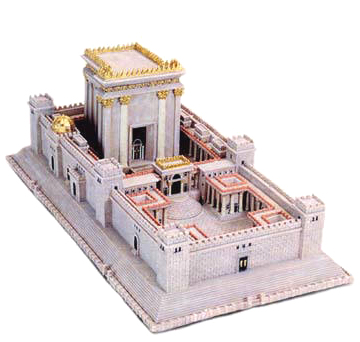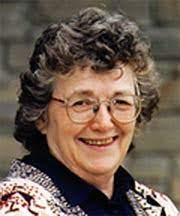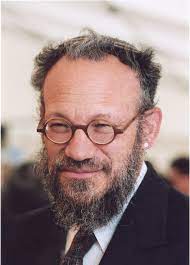There are several views of how Judaism
and Christianity originally related.
View 1: Christianity is the true Israel
A very common view among early Christian writers is that the Church is the new Israel, and that Judaism has lost its status as the people of God as a result of its many backslidings and errors. Several polemical treatises adversus Judaeos ("against the Jews"), such as this one by Tertullian, make this argument. Similarly, Jewish writers of the time commonly take the view that Christians, through their errors and shortcomings, have been removed from Israel. For theologians, a problem with Tertullian's view is that it seems to make God's grace dependent on human righteousness, a form of Pelagianism. And this view is of little help to historians, whose primary question is "What happened?" rather than "Who will go home justified?"
View 2: The two faiths parted ways in the 1st century
In this view, in Jesus' time, there were quite a large number of Jewish groups (as there are today), but it's customary to identify two major ones, the Pharisees and Sadducees. The first was led by scholarly teachers called rabbis, and it was focused on the synagogue; the second was led by aristocratic families of high priests, and  focused on the Temple. Christianity originated as a sect within Judaism — perhaps within Pharisaism, given Jesus' preaching in synagogues and his criticisms of the Temple. By CE 70 or so it was posing a considerable threat to the mother faith. At the same time, i.e., CE 70, the Roman army destroyed the temple in Jerusalem (a model is pictured to the left), which ended the influence of the Saduccees. Consequently, the future of Judaism lay with the rabbinic type. In the traditional narrative (which has its critics), a big step towards the ascendancy of rabbinic Judaism was the establishment by a disciple of Rabbi Hillel of a rabbinic academy in Javneh (Jamnia, Yavneh). Another step was the meeting of an important Jewish council in that same town in the CE 70s, 80s, or 90s. This council formally condemned the Christians, and also established the authoritative Hebrew canon of the Old Testament. The Council of Jamnia represents the "parting of the ways" between Christians and Jews. From this point, the two faiths develop independently, though with considerable rivalry. The emperor Constantine's conversion to Christianity in the 310s more or less ends the rivalry, since from now on the church will be socially and politically important, while the synagogue will be socially and politically marginalized.
focused on the Temple. Christianity originated as a sect within Judaism — perhaps within Pharisaism, given Jesus' preaching in synagogues and his criticisms of the Temple. By CE 70 or so it was posing a considerable threat to the mother faith. At the same time, i.e., CE 70, the Roman army destroyed the temple in Jerusalem (a model is pictured to the left), which ended the influence of the Saduccees. Consequently, the future of Judaism lay with the rabbinic type. In the traditional narrative (which has its critics), a big step towards the ascendancy of rabbinic Judaism was the establishment by a disciple of Rabbi Hillel of a rabbinic academy in Javneh (Jamnia, Yavneh). Another step was the meeting of an important Jewish council in that same town in the CE 70s, 80s, or 90s. This council formally condemned the Christians, and also established the authoritative Hebrew canon of the Old Testament. The Council of Jamnia represents the "parting of the ways" between Christians and Jews. From this point, the two faiths develop independently, though with considerable rivalry. The emperor Constantine's conversion to Christianity in the 310s more or less ends the rivalry, since from now on the church will be socially and politically important, while the synagogue will be socially and politically marginalized.
View 3: Christianity repudiated Judaism
Some liberal Protestant historians, such as
Adolf von Harnack (1851–1930), and some Biblical commentators, have argued that Paul, and others in early Christianity, and maybe even Jesus himself, understood Christianity as distinct from Judaism, and that they actually condemned Jewish doctrine, practice, and identity. Thus the separation of Christianity and Judaism wasn't just a
 circumstantial event in the second or third generation of Christianity; it's actually an essential part of the Christian gospel. Historically, this view helped undergird the Nazi persecution of the Jews in the 1930s and early 1940s. It has also been adopted by more radical writers such as Rosemary Radford Ruether and
Gregory Baum, with the difference that, whereas the liberals think that the early Christian denunciation of Judaism was a natural thing to have happened, the radicals think that it was wrong. If you have U of T library access, check out this entry from "Oxford Bibliographies. Biblical Studies" which summarizes the case for and against anti-semitism in the New Testament.
circumstantial event in the second or third generation of Christianity; it's actually an essential part of the Christian gospel. Historically, this view helped undergird the Nazi persecution of the Jews in the 1930s and early 1940s. It has also been adopted by more radical writers such as Rosemary Radford Ruether and
Gregory Baum, with the difference that, whereas the liberals think that the early Christian denunciation of Judaism was a natural thing to have happened, the radicals think that it was wrong. If you have U of T library access, check out this entry from "Oxford Bibliographies. Biblical Studies" which summarizes the case for and against anti-semitism in the New Testament.
View 4: Christianity and Judaism were siblings
In the 1950s several Jewish scholars, such as Jacob Lauterbach and Alan Segal, and some Christian scholars too, wanted to account for two realities: (1) Since there were lots and lots of Jewish sects in the first century, there wasn't some Generic Judaism from which Christianity could have been born; and (2) Not only did Judaism influence Christianity, but Christianity influenced Judaism as well. They therefore argued that both modern Judaism and modern Christianity came into existence out of a common first-century religious heritage. Christianity and Judaism are like Jacob and Esau, the twin sons of Rebecca.
IView 5: Christianity created Judaism
 Daniel Boyarin, a Talmudic scholar at the University of California, Berkeley (see his home page), and others, have more recently been contending that both Judaism and Christianity were so highly diverse before Constantine that it's not possible to draw clear boundary lines between them. (See links at the left.) Similarities and mutual influences among texts, and some rare documented examples of shared worship, figure in the argument. Not until Christians moved out of their multiple divisions towards a common identity, and not until Jews did the same, was it possible for Christians and Jews to think of themselves as two rival religions. This mutual self-differentiation began to happen in the years following 160, and it was a long process. There was no Council of Jamnia, these scholars say. The evidence of the Mishnah for rivalries between Christians and Jews in the first century has to be discounted, because the Mishnah dates from around CE 200, and was written partly to justify the separation of Christians and Jews (by retrojecting it anachronistically onto an earlier time). There was no tidy "parting of the ways." In an article dramatically titled "Justin Martyr Invents Judaism" (accessible from a link at the left for those with U of T library accounts), Boyarin argues that a Christian writer in Rome, Justin Martyr (d. ca. 165), was the first person to draw boundaries around something called the Church that would eliberately exclude the Jews. Jewish leaders began developing an idea of a self-identical Judaism only after Christians had already developed an idea of the Church in distinction from Judaism; in that sense, Christianity is older than Judaism.
Daniel Boyarin, a Talmudic scholar at the University of California, Berkeley (see his home page), and others, have more recently been contending that both Judaism and Christianity were so highly diverse before Constantine that it's not possible to draw clear boundary lines between them. (See links at the left.) Similarities and mutual influences among texts, and some rare documented examples of shared worship, figure in the argument. Not until Christians moved out of their multiple divisions towards a common identity, and not until Jews did the same, was it possible for Christians and Jews to think of themselves as two rival religions. This mutual self-differentiation began to happen in the years following 160, and it was a long process. There was no Council of Jamnia, these scholars say. The evidence of the Mishnah for rivalries between Christians and Jews in the first century has to be discounted, because the Mishnah dates from around CE 200, and was written partly to justify the separation of Christians and Jews (by retrojecting it anachronistically onto an earlier time). There was no tidy "parting of the ways." In an article dramatically titled "Justin Martyr Invents Judaism" (accessible from a link at the left for those with U of T library accounts), Boyarin argues that a Christian writer in Rome, Justin Martyr (d. ca. 165), was the first person to draw boundaries around something called the Church that would eliberately exclude the Jews. Jewish leaders began developing an idea of a self-identical Judaism only after Christians had already developed an idea of the Church in distinction from Judaism; in that sense, Christianity is older than Judaism.
Early Jewish Christianity
The late distinguished Roman Catholic historian of early Christianity Jean Cardinal Daniélou, published his influential The Theology of Jewish Christianity; in French in 1958 (an English translation, with some inaccuracies, was published in 1964). By analyzing the remaining literature of the first century or so of the common era, he recognized a vigorous and diverse array of Christian and Jewish expressions. He put extreme outliers to one side and focused on works that appeared to him more normatively orthodox. Many of these works had so much in common that they were hard to attribute uniquely to Judaism or Christianity. Common elements included the figure of Jesus, messianic themes, commentary on Old Testament Scripture, apocalyptic interpretations of events, angelologies, and presentations of spiritual and moral practices. Even works recognizably Christian, such as Didaché, I Clement, and the letters of Ignatius, had much in common with contemporary works that are recognizably Jewish. Some of the NT apocrypha, OT apocrypha (such as the Ascension of Isaiah, and the Testaments of the Patriarchs), some subapostolic works such as Shepherd of Hermas, and fragments quoted in later works, could look both Jewish and Christian, by later standards of Judaism and Christianity. Daniélou's conclusion was that these can be seen as expressions of an early Jewish Christianity that had its own theological coherence.
Whether the idea of a Jewish Christianity supports or subverts the model of a "parting of the ways" can be disputed. Recently, Matt Jackson-McCabe of Cleveland State University and John Collins of Covenant Theological Seminary have argued, in Jewish Christianity: The Making of the Jewish-Christian Divide, that there was no "early Jewish Christianity," as if it were a distinct movement, but simply numerous groups and writings that existed in a world where the two faiths had not yet been distinguished.
The recognition that a Jewish Christianity continued past the first century, and that Jewish and Christian expressions of the faith may have taken centuries to distinguish, points to the untidy, rich, and creative realities of the early Christian communities.